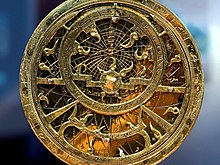Залаты век ісламу

Залаты век ісламу — перыяд культурнага, эканамічнага і навуковага росквіту ў гісторыі ісламу, які традыцыйна датаваны з 8 па 14 ст. [1] [2] [3] Традыцыйна лічыцца, што гэты перыяд пачаўся ў часы праўлення абасідскага халіфа Харуна ар-Рашыда (786—809) з адкрыцця Дома мудрасці ў Багдадзе, найбуйнейшага на той момант горада свету, дзе ісламскія навукоўцы і паліматы з розных частак свету з розным культурным паходжаннем было даручана сабраць і перакласці ўсе вядомыя сусветныя класічныя веды на сірыйскую і арабскую мовы.[4]
Традыцыйна кажуць, што гэты перыяд скончыўся з распадам халіфата Абасідаў у выніку мангольскіх нашэсцяў і аблогі Багдада ў 1258 годзе [5] Некаторыя навукоўцы датуюць канец залатога веку каля 1350 г. звязваючы з эпохай Тымурыдаў [6] [7], у той час як некаторыя сучасныя гісторыкі і навукоўцы адносяць канец ісламскага залатога веку да канца 15-16 стст. Эпоха ісламскіх порахаў.[8] [9] [10] (Сярэднявечны перыяд ісламу вельмі падобны, калі не аднолькавы, адна крыніца вызначае яго як 900–1300 гг. ) [11]
Зноскі
- ↑ George Saliba (1994), A History of Arabic Astronomy: Planetary Theories During the Golden Age of Islam, pp. 245, 250, 256–57. New York University Press, ISBN 0-8147-8023-7.
- ↑ King, David A.. The Astronomy of the Mamluks. pp. 531–55.
- ↑ Hassan, Ahmad Y (1996). “Factors Behind the Decline of Islamic Science After the Sixteenth Century”. in Sharifah Shifa Al-Attas. Islam and the Challenge of Modernity, Proceedings of the Inaugural Symposium on Islam and the Challenge of Modernity: Historical and Contemporary Contexts, Kuala Lumpur, 1–5 August 1994. International Institute of Islamic Thought and Civilization (ISTAC). pp. 351–99. http://www.history-science-technology.com/articles/articles%208.html.
- ↑ Gutas, Dimitri 1998. Greek Thought, Arabic Culture: The Graeco-Arabic Translation Movement in Baghdad and Early ‘Abbāsid Society (2nd-4th/8th-10th Centuries). London: Routledge.Шаблон:Pn
- ↑ Islamic Radicalism and Multicultural Politics. Taylor & Francis. https://books.google.com/books?id=JdC90uc8PfQC&pg=PA9. Retrieved on 26 August 2012.
- ↑ Science and technology in Medieval Islam(нявызн.). History of Science Museum.
- ↑ A Companion to the Worlds of the Renaissance, Guido Ruggiero. https://books.google.com/books?id=fx0Dlwb18WYC&q=Timurid+renaissance&pg=PA59. Retrieved on 7 November 2016.
- ↑ George Saliba (1994), A History of Arabic Astronomy: Planetary Theories During the Golden Age of Islam, pp. 245, 250, 256–57. New York University Press, ISBN 0-8147-8023-7.
- ↑ King, David A.. The Astronomy of the Mamluks. pp. 531–55.
- ↑ Hassan, Ahmad Y (1996). “Factors Behind the Decline of Islamic Science After the Sixteenth Century”. in Sharifah Shifa Al-Attas. Islam and the Challenge of Modernity, Proceedings of the Inaugural Symposium on Islam and the Challenge of Modernity: Historical and Contemporary Contexts, Kuala Lumpur, 1–5 August 1994. International Institute of Islamic Thought and Civilization (ISTAC). pp. 351–99. http://www.history-science-technology.com/articles/articles%208.html.
- ↑ Arts of the Islamic World: the Medieval Period(нявызн.). Khan Academy.
Катэгорыя·Гісторыя культуры
Катэгорыя·Вікіпедыя·Шаблон «Вонкавыя спасылкі» пусты
Катэгорыя·Старонкі з няправільным сінтаксісам спасылак на крыніцы